The educational program
Retraining of cramped muscles and joints is impossible if the equipment that brought about these habits is still in use. On the other hand, changing the equipment will not be enough if these habits are left as they are. During the course of an entire school year, our musicians underwent a process of re-training using the Alexander Technique to eliminate old habits built up over years of cramped playing. As muscular habits softened and changed, the musicians' ideas and perceptions of playing also changed.
We made sure that the musicians had enough support to carry out the changes they needed by combining weekly private lessons in the Alexander Technique and group meetings with frequent fittings of equipment and monitoring of playing. This meant that each student had supervised work 2 or 3 times a week during an entire school year.
Alexander Technique*
During weekly private lessons the Alexander Technique teacher used his/her hands to coax stiffened neck, arm and back muscles to freer movement, using verbal instruction for clarification. This gave the musician a chance to find out where he or she had been stiffening or shortening the stature. By experiencing a contrast to their usual way of moving, the musician was able to learn to observe where and when he might be stiffening the neck, arms, back or legs and learn to prevent these patterns of stiffening during playing. We worked with and without the instrument, improving mobility and coordination.
“I didn’t know that being aware of where your head is improves the sound! In my Alexander Technique lessons I learned what position is normal for my body, and how to find my balance. ” -Iren
Private Alexander Technique lessons began eight weeks before making the first changes in the chin or shoulder rest. This prepared the musicians by giving them some experience in releasing habits of muscular tension that they had used to hold the instrument.
We often worked first without the instrument, re-establishing lost range of movement, then re-introducing these movements into the playing technique:
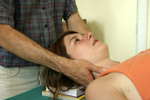
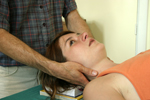
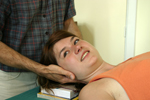
Monica allows the Alexander Technique teacher to turn her head for her, demonstrating free movement in the upper spine. At the beginning of the project all our players had built-up tension that made it difficult to turn their heads freely.
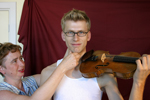
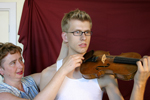
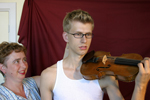
The same free turn of the head is practiced with the violin. Leaving his head free to be turned by the teacher, Huug can feel where the top of his neck is, and how his head balances on the spine.
*The Alexander Technique has been in the curriculum of music conservatories world-wide for many years. You can read more about the musicians’ experiences with the Alexander Technique in Musician-stories. For a general description of the Alexander Technique see www.stat.org.uk and www.alexandertechniek.nl.
Re-establishing poise and control
During an Alexander Technique lesson one can work to re-establish the true length of a cramped neck, helping the player to re-discover how to move the head freely. Poise, which feels strange at first, becomes possible, then familiar, and the musician can then maintain it for himself when faced with the challenges the instrument presents. Re-establishing poise in the head, neck and back, not only improves coordination, but also the reliability of perception, since the position of the head is what orients us to know where we are in the world.
“Before, I sometimes could play something that sounded O.K. but I wasn’t sure I could repeat it. I don’t know what I was doing, but I know that it was not real control. Now I know exactly what I am doing. I can observe what is happening, seeing more details. Now I am confident that real control is coming.” - Ian
A decrease in the overall muscle tension also calms the musician, giving him the serenity to observe and act differently. By calmly observing themselves under supervision, players increase their ability to monitor what they are doing while playing, which improves the quality of practicing and technique. In this way, causes of discomfort and pain can be eradicated. Increased awareness also brings more reliable results in playing, leading to increased self-confidence and musical boldness.
“Eventually, by working alone and with my Alexander Technique teacher, I was also able to get rid of the main background stiffness in my neck and head. This gave me more security in my playing. My sound got stronger because there was more length in my back and a freer neck.” - Monica
Active, not over-relaxed
When musicians have struggled for a long time against excessive tension in their playing, they often have learned to cope by over-relaxing certain parts of their body. This can mean that some parts of the body are unnecessarily tensed, and others over-relaxed, which causes both immobility and heaviness. For example, an over-relaxed wrist may be used to compensate for stiffness originating further up the arm. Alexander Technique lessons help the musician to recognize and to re-establish the healthy, active, muscle tone necessary for playing.
“Before I had my Alexander lessons, I misunderstood what it means to ‘play in a relaxed way’. Since I only thought of ‘relaxing’, my body got very heavy. Instead, I now play in an active way. You have to be active, to be able to move at all times while playing. That way you can have the energy all the time and then use it exactly when you need to, without first having to wake yourself up!” - Ian
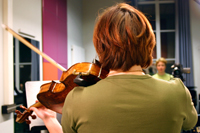
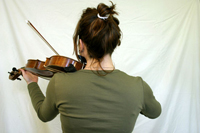
1. *The weight of the instrument drags the player down. Monica before the research, Nov. ’03
2. Back and arms are able to meet the demands of supporting the weight of the instrument. Monica at the end of the research, June ’04
Improved strength in the postural muscles means that the instrument can be held up more easily, decreasing fatigue.
Re-orienting
Changes in equipment and position of the instrument alter the context in which a player functions. After years of playing, the performer has gotten used to having the instrument fixed in a specific position determined by the equipment. Re-adjusted equipment can feel more comfortable on the body, but also requires a change in the movement patterns of the player. The instrument is suddenly in a different position in relation to the hands, arms and face of the player. Removal of the barriers to freer movement initially feels strange.
“Immediately I felt comfortable with my new equipment. On the other hand, everything started to feel more complicated. After playing more than ten years in the same old position, it was difficult to change everything in a moment.” -Iren
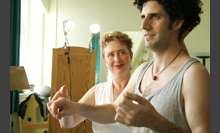
A change in the chin rest or shoulder rest alters the position of the violin in relation to the face (eyes and ears) and the inner ear. Angles for bowing and fingering also change. In the beginning, cramped playing styles feel normal, and new freer movement patterns feel unaccustomed and strange. It takes time and attention to get used to new options for movement that were not available before.
Mikkel tries out a more open playing position.
“When we first made the changes, the bow wasn’t parallel with the bridge. The left hand was completely disorganized in relation to new position of the fingerboard. With the violin more in front of me, the sound suddenly came from a different place than before. This temporarily confused the balance of my head and was disorienting.” –Iren
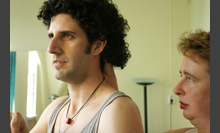
The Alexander Technique lessons aided the process of re-orienting to new equipment and instrument position by helping the players to repeatedly re-establish their balance during a period of change. This gave them a reliable standpoint from which to observe and adjust their playing. Most players reported that this spatial re-adjustment in their playing generally took no more than two weeks.
Maintaining the balance of the head on the spine helps us to re-orient in new situations.
“In my Alexander Technique lessons we tried to find a good balance of my head and neck, which was very reassuring and helped me to work well with the new violin position.” - Iren
>>the Experience
>>Adjusting the violin position
Seeing the big picture
Violinists and violists often concentrate only on their hands and arms when practicing. By learning to experience and observe themselves as a whole, the musicians in our study noticed that technical improvement could also come from other sources.
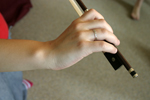
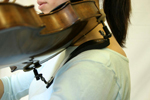
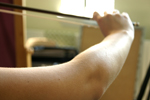
The musicians were used to concentrating solely on their hands and arms while playing.
Strength, coordination and accuracy are all affected by the basic balance in the body. Working on improvement of the coordination of head, neck, back, arms and legs during their private Alexander lessons contributed to an improved coordination of all playing movements. Playing technique improved as coordination improved. During the research, the students reported developing an ability to observe themselves which they could continue to incorporate into their practicing, playing and daily lives.

As the Alexander Technique teacher works with neck, back, arms and legs, the musician becomes more aware of the whole body, and how the parts relate.
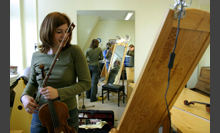
“The Alexander lessons helped…to make me aware that everything is happening in the centre of my body, not just in the right and left hands. Now I am aware of the relation between head, neck, and back that allows them to work together. This coordination contributes to the development of a brilliant technique.” – Monica
Group meetings
Weekly group meetings helped to create a social and educational climate for discussion and exploration, taking the loneliness and feeling of exile out of the process of change. Aspects of anatomy, use of the equipment, practicing, physical and emotional issues were all presented and discussed.
In the conservatory and professional environment of the musician, where performance takes a central role, the emphasis is often placed on production: learning the next piece or etude. The research project, having no playing deadlines, could be taken as a “time out” from producing. The group gave a context for taking time to look at the process of playing and learning in new ways, giving permission to focus on the development of coordination and observational skills to make long-term playing progress possible.
To read more about this see >>The Experience >> Safety in Numbers
Frequent fittings and monitoring of playing
The process of adjusting the chin rest and shoulder rest continued throughout the entire school year. Frequent fittings assured that the pace of change was comfortable for each individual. When the old equipment stopped dictating a single position of the instrument, the musician had more choice in movement patterns. Retraining cramped playing habits allowed repositioning of the instrument to conform to the natural movements of arms and hands. Re-establishing length and width in the player's neck and back permitted readjustment of chin and shoulder rests. This process of alternating changes in technique with changes in equipment and instrument position resulted in improved comfort, ease of playing, and quality of performance.
>>Re-aligning the equipment
>>Adjusting the violin position
